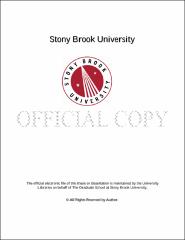| dc.identifier.uri | http://hdl.handle.net/11401/77458 | |
| dc.description.sponsorship | This work is sponsored by the Stony Brook University Graduate School in compliance with the requirements for completion of degree. | en_US |
| dc.format | Monograph | |
| dc.format.medium | Electronic Resource | en_US |
| dc.language.iso | en_US | |
| dc.publisher | The Graduate School, Stony Brook University: Stony Brook, NY. | |
| dc.type | Dissertation | |
| dcterms.abstract | A central problem in biomedical signal processing research is that of computer aided classification. We consider the problem of computer-aided diagnosis of intrapartum fetal status based on simultaneously recorded fetal heart rate (FHR) and uterine pressure (UP) signals. Clinically, visual diagnosis of the fetal heart rate signal is of critical importance when evaluating the status of pregnancy and delivery. This is because oxygen inadequacy, a major cause of adverse fetal outcomes, has a direct effect on the fetal heart rate. Purely visual assessment of fetal heart rate segments has, however, proven to have high intra- and inter observer variability, which has persisted despite the publication of standardized interpretation guidelines, such as those by the National Institute of Child Health and Human Development (NICHD). This has led to an alarming increase in the rate of caesarian sections and unnecessary litigation expenses in even simple cases. Thus, the development of automated algorithms for accurate classification of FHR-UP patterns is of paramount importance. The main contribution of our research is the development of different Bayesian classification approaches that utilize two distinct paradigms for feature extraction: (a) summarizing patterns from long-duration data sets and (b) using sequences of features derived from short data-lengths. In most of the existing methods, feature-vectors for long-duration (10-20 minutes or more) datasets are mapped to scalar values. This approach ignores the inherent non-stationarity in, and the effects of short-term interactions between the two time series. In order to account for these factors, we develop methods to extract informative features from short time-series data, and then use sequences of such features as classifier input. We used these feature inputs in conjunction with classification methods based on density estimation using window-counting, Bayesian-network structure detection and generative mixture models. In particular, Bayesian network structure detection enables the discovery of novel correlations and causations amongst different features. Generative mixture models turn out to be ideally suited for the modeling and classification of the feature-sequences described earlier, and to elegantly fuse information from both FHR and UP patterns. We explore a variety of features derived from expert-consensus guidelines and statistical metrics that quantify information about the series of beat-to-beat fractional changes in FHR. We also develop methods to accurately translate clinical guidelines for FHR categorization into algorithmic rules for decision-making. We describe the use of the NICHD guidelines to make such deterministic systems, which are compared to the aforementioned probabilistic classifiers. The methods presented here have the potential to make accurate FHR-UP monitoring and automated decision support a possibility. We carried out rigorous performance evaluations of these techniques on several datasets acquired from real subjects. We show improvements in classification accuracy versus discriminative methods such as support vector machines and rule-based classifiers. Gold-standard labeling was done using manual physician interpretations of FHR-UP recordings or an objective fetal health metric (umbilical cord pH). This work also opens up several possibilities for future research, including unsupervised clustering of FHR-UP patterns using nonparametric Bayesian methods with generative models, development of fetal ``risk scores'' based on these discovered models, and the use of sampling techniques to automatically segment FHR-UP time-series data into distinct patterns. | |
| dcterms.available | 2017-09-20T16:52:44Z | |
| dcterms.contributor | Bugallo, Monica | en_US |
| dcterms.contributor | Djuric, Petar M | en_US |
| dcterms.contributor | Subbarao, Murali | en_US |
| dcterms.contributor | Quirk, J. Gerald. | en_US |
| dcterms.creator | Dash, Shishir | |
| dcterms.dateAccepted | 2017-09-20T16:52:44Z | |
| dcterms.dateSubmitted | 2017-09-20T16:52:44Z | |
| dcterms.description | Department of Electrical Engineering. | en_US |
| dcterms.extent | 143 pg. | en_US |
| dcterms.format | Application/PDF | en_US |
| dcterms.format | Monograph | |
| dcterms.identifier | http://hdl.handle.net/11401/77458 | |
| dcterms.issued | 2015-08-01 | |
| dcterms.language | en_US | |
| dcterms.provenance | Made available in DSpace on 2017-09-20T16:52:44Z (GMT). No. of bitstreams: 1
Dash_grad.sunysb_0771E_11904.pdf: 13551347 bytes, checksum: a6ea9b2399a23c3327eabeaf9a42d973 (MD5)
Previous issue date: 2014 | en |
| dcterms.publisher | The Graduate School, Stony Brook University: Stony Brook, NY. | |
| dcterms.subject | Electrical engineering | |
| dcterms.subject | Bayesian methods, fetal heart rate, generative models, graphical models, machine learning, signal processing | |
| dcterms.title | Bayesian methods for feature extraction and classification of fetal heart rate signals | |
| dcterms.type | Dissertation | |

